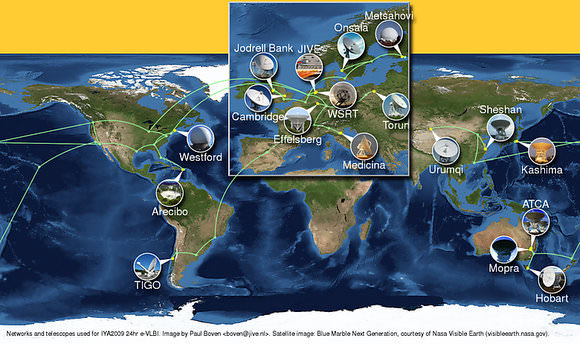[/caption]
Telescopes located all around the world are being used together to work in real-time as a single gigantic instrument. As part of the opening events for the International Year of Astronomy 2009 in Paris, (watch live) a nearly continuous 33-hour observation is being conducted on January 15-16. 17 telescopes in Asia, Australia, Europe, North America and South America, are taking part in the mammoth project.
Using an astronomical technique called electronic, real-time Very Long Baseline Interferometry, or e-VLBI, participating telescopes will observe the same object simultaneously. Data from each telescope will be streamed across the globe through high-speed optical networks to a purpose-built supercomputer at JIVE in the Netherlands. This machine acts as the focus of the giant distributed telescope, the largest real-time telescope ever, combining the signals collected from instruments across the world.
Here’s a link to a page that shows webcams from the participating sites.
Link to a page that displays cumulative on-the-fly generated plots of the selected type. Approximately every 5 minutes a new image is generated, incorporating all the data collected so far; they are being being built up as the experiment progresses.
“By combining information from such widely separated radio telescopes we can produce incredibly sharp images with up to one hundred times better resolution than those available from the best optical telescopes”, said Simon Garrington, Director of the UK’s MERLIN/VLBI National Facility. “It’s like being able to sit here in Manchester and read a newspaper in London”.
With e-VLBI the ability to send data electronically and combine it in real-time has the additional advantage of providing results to astronomers within hours of conducting an observation, rather than weeks later via the traditional VLBI method of recording data onto disks and shipping it to the correlator.
JIVE Director Huib Jan van Langevelde explained, “With VLBI we can zoom in on the most energetic events in the universe, and the new e-VLBI technique allows us to do this fast enough to catch such events on the time-scale that they occur and respond quickly.”
Source: eVBLI site
, PhysOrg


Wow… Just wow. That’s unbelievably cool!
That is a WOW!
Can’t wait to see the images.
Been there, done that.
Now can we please get some discs on the Moon?
Why settle for a 25 Mm aperture when you can have 400 Mm?